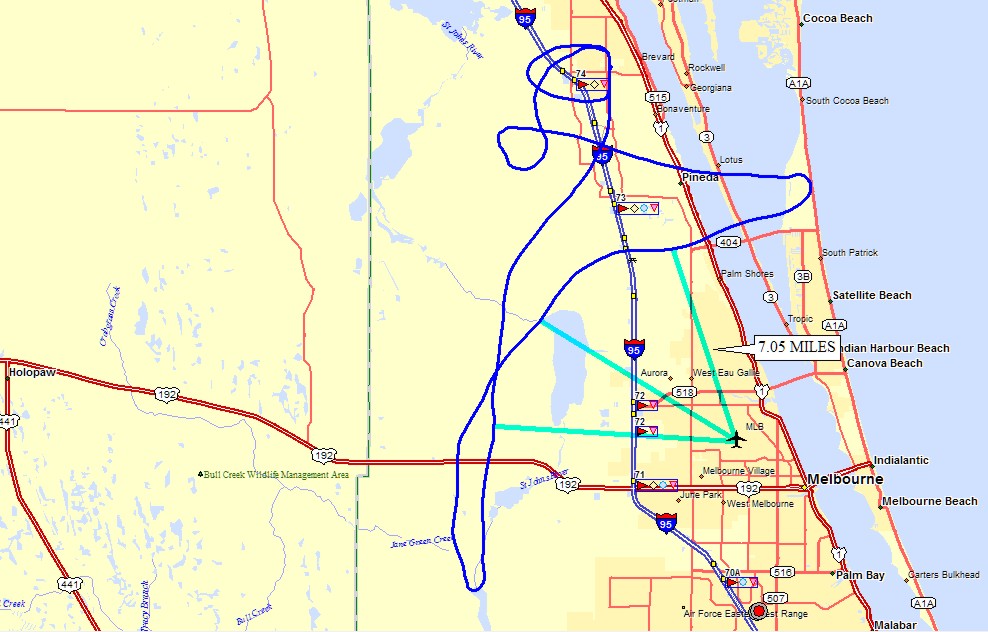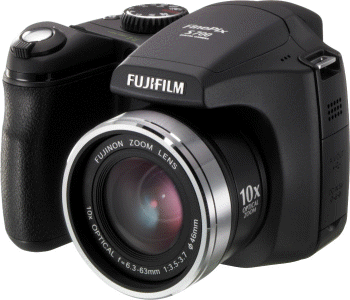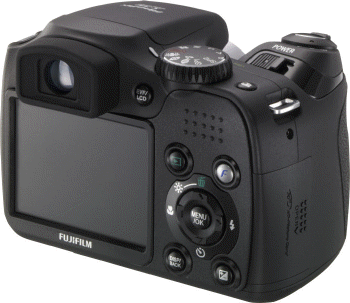The Thunderbirds at Melbourne · · PAGE 382.
October 5, 2014: It is another Sunday to go
flying except for the Temporary Flight Restriction at the Melbourne Airport where the US
Air Force precision flight team "The Thunderbirds" are giving a show today.
I plan to see it from the air at a distance of 7 to 8 miles from the center of the
MLB airport and outside the limits of the TFR that is from the surface to 16,000 feet.
This photo is the first taken of the airplane with the new digital single-lens
reflex camera (DSLR). It is an older Canon Rebel XT camera body with a couple of
Sigma zoom lenses with electronic auto-focus. I brought the digital camcorder today
and fired up the dash-mounted color TV camera and connected the intercom system to the
audio input of the camcorder.
I started the camcorder when I was passing over Patrick AFB and setting up for
a pass along the north side of the Melbourne Airport at a range of about EIGHT miles from
the center of the airport. I kept pointing the video camera at the airport as I flew
around the north and west side of the MLB Airport. I was west-northwest of the
airport when I saw the team take off in a formation of four F-16's. I had
reached a point about 9 miles southwest when I turned around and headed north. I
turned my video camera toward the airport again looking out the right side of the airplane
and took this still camera photo at about the same time. At least one of the F-16's
had made a low pass over the runway from west to east and climbed straight up with smoke
on to mark his flight path. Some of the smoke lingers in this hazy photo. The
hazy cloud layer seen here is at about 4000 MSL and is out over the ocean. I am
cruising at about 3,500 feet MSL. My windshield roll bar is the dark edge of this
photo. The camera auto-focus worked properly.
From this distance greater than 8 miles, there is not much to see.
The main thing to do today was to fly and run the video camera and try out the
"new" Canon digital SLR camera. Seeing the F-16's was not as good as I
hoped. I listened on the "air boss" control tower frequency and heard him
talking to the other air show performers before the Thunderbirds performed. They
were on a military frequency and I heard nothing on the radio after 3 PM when they took
off. My ride back to the Rockledge Airport was uneventful as it should be.
That white building in the haze is the Vertical Assembly Building (VAB) at the Kennedy
Space Center. It is 500 feet high since it was built to stack up Saturn 5 moon
rockets which were 363 feet tall when they took off from Launch pads 39A and 39B.
The Space Shuttles were much shorter, but still used the same launching pads.
The video camera was on through most of the flight and for the landing. I
used the new still camera for the usual "back in the hangar" photo. I will
process the video and post it on the web site soon. The GREEN bag on the wing is for
the new camera.
Here is the GPS ground track for today's flight. The TFR had a 5-nautical
mile radius around the Melbourne Airport which is 5.75 statute miles. My closest
approach was 7.05 statute miles. The other two measurements are greater than 8
statute miles.

The Hobbs meter had 360.0 hours on it at the end of the day.
October 25, 2014: Today
was the day to warm up the engine and test the compression for the cylinders. The
GPS ground track below shows the warm up flight, then the test flight after cleaning the
spark plugs and checking the fuel filter screen in the gas collator, reassembling it, and
checking for fuel leaks with Bill as my eyes with the boost pump on in the hangar.
The Hobbs meter now has 361.0 hours on it after two takeoffs and landings. I flew
toward the Titusville Airport (KTIX) to check out my VOR and glide slope functions of my
Garmin SL-30 receiver by tracking the ILS approach to see both needles active on the
GI-106 resolver. After that test, I made sure not to get too close to Dunn Airpark
on the north side of Titusville where sky divers jump from 14,000 feet MSL. That test
flight completed my annual inspection.

Speaking of VOR systems, the one on the field at Melbourne has been de-commissioned as GPS becomes the primary navigation for aviation. The ILS systems will eventually be the only signals for my Garmin SL-30 NAV radio section. I will see if the major VOR transmitters on the VICTOR airways are going to remain active.
The last time I changed cameras for use on this web site, I gave a send off to the old Fuji which had taken much abuse being blown off the wing at engine start and dropped a few times. The changing of the guard took place on PAGE 236 of this web site. Here is a refresher for those who have forgotten.
April 29, 2007: The old Fuji digital camera
is officially retired after the beating it has taken since I got it in November 2002.
It has served me well in publishing this web site, but it finally has problems that
are not easily fixed by restoring a loose connection, etc. The old 2650 could take
2-megapixel photos, while the new Fuji S700 takes up to 7.1-meg shots. I took this
one using 2-meg settings and reduced it from 1600x1200 to 960x720 for the usual display
size on this web site.
Here are the web advertising photos of my new camera that took the photo above and all that you will see going forward on this web site. The new feature for me on this model is the ability of the camera to use 46mm filters in front of the zoom lens. The big advantage will be the removal of reflected glare seen on the inside of the windshield and canopy in some of my cross country photos.
 |
 |
October 29, 2014: Here are the photos showing the
still working Fuji S700 with its pop-up flash showing signs of wear, but everything else
works perfectly. I used the new Canon DSLR to take this photo on the kitchen table.
The 46mm polarizing filter that I bought when I was using a Miranda Sensorex film
camera was a perfect fit for the Fuji S700.

The old Canon Rebel XT camera body is the digital SLR that I recently bought on
eBay for around $70. The pop-up flash works perfectly! The two Sigma zoom
lenses came from my step daughter because her old camera body was a Canon TI 35 mm film
camera. These are electronic auto-focus lenses that are fully-compatible with the
Canon Rebel XT body. The smaller lens is a 28 mm to 80 mm macro zoom for general
purpose photos. The larger lens on the left is a 70 mm to 300 mm zoom lens that
varies in length from 5 inches to 7 and 3/8 inches. The polarizing filter in front
of the camera is a 55 mm polarizing filter I found in my Miranda camera stuff that fits
the larger 28-80 mm zoom lens.
Today is the 100th anniversary of my father's birth in 1914. He died in 1972 at age 57 when I was 24 years old. I am now age 67 and still passing my FAA stress tests to keep my aviation medical current.
| CLICK HERE for PAGE 383 | Return to MAIN MENU |